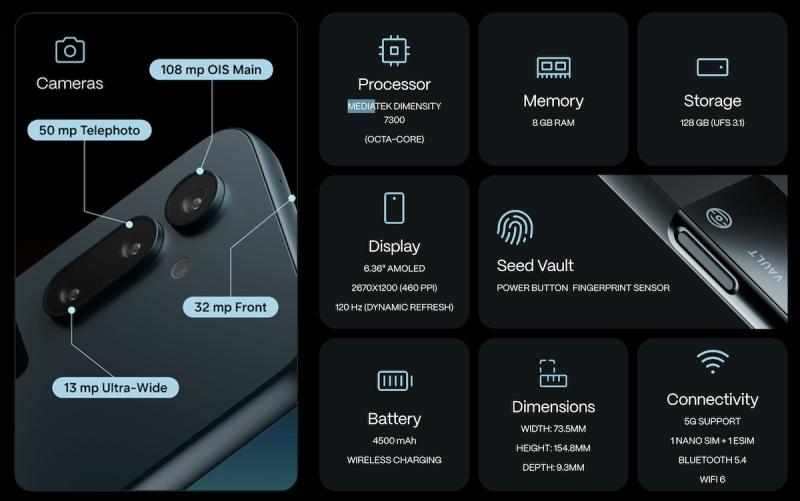Solana Mobile will begin shipping its next-generation Web3 smartphone, the Solana Seeker, on August 4, 2025. With over 150,000 pre-orders already placed, the Seeker builds on lessons from its predecessor, the Solana Saga, and introduces two major innovations: a decentralized mobile infrastructure called TEEPIN and an integrated ecosystem token SKR.
Positioned as a response to the limitations of centralized app ecosystems, the Seeker is designed to give developers direct access to users and empower those users with greater control over their device and identity—without relying on traditional gatekeepers like Apple or Google.
Key Takeaways
-
Launch Date: Global shipping begins August 4, 2025, with over 150,000 pre-orders.
-
Architecture: TEEPIN enables decentralized app delivery, firmware verification, and system updates.
-
Token Utility: SKR rewards user activity, developer engagement, and hardware support.
-
On-Chain Identity: Seeker ID combines wallet address, Genesis Token, and secure hardware credentials.
-
Market Strategy: Solana Mobile plans to license TEEPIN and SKR to other hardware manufacturers.
Solana’s Vision: A Challenge to Apple and Google
According to a co-founder of Solana Labs, Anatoly Yakovenko, the Seeker is not just a device—it’s an attempt to build a top-tier mobile ecosystem that can rival tech giants like Google and Apple:
“The goal of Seeker is to build a top tier mobile ecosystem that can compete with Google and Apple. Crypto is the wedge to do it. TEEPIN is the implementation. Chance of failure – nearly certain, opportunity – enormous.”
He likens the strategy to cloning an iPhone in every way except for the root certificate, which is the key to Apple’s walled garden:
“Apple’s network effects and business models are enforced not with a pen or the sword, but with cryptography and the TEE hardware on device.”
In the Seeker ecosystem:
-
All hardware features TEEs (Trusted Execution Environments) that only boot verified OS images.
-
A DAO on Solana manages the root certificate, determining policies and economic models.
-
The DAO can enforce rules for app deployment, device access, and revenue distribution directly from the blockchain.
This model offers the possibility of decentralizing one of Apple’s most powerful strategic levers—its hardware-software trust system.

Source: Solana Seeker
Transforming Mobile OS: How TEEPIN Works
The Seeker’s foundation is TEEPIN (Trusted Execution Environment Platform Infrastructure Network), a decentralized three-layer system that replaces conventional app store models with direct developer-to-user app delivery.
-
Hardware Layer: Uses cryptographic proofs to ensure system integrity—think of it as a built-in lie detector for your phone’s core software.
-
Platform Layer: Employs an on-chain registry to validate OS versions and distribute updates.
-
Network Layer: Maintains a decentralized audit trail for firmware and software changes, increasing transparency and trust.
By eliminating centralized app stores, TEEPIN grants users more control while enabling developers to reach audiences without intermediary restrictions.
SKR Token and Seeker ID: Bridging Blockchain with Hardware
SKR, the Seeker’s native token, drives incentives across the Solana Mobile ecosystem. Users earn SKR by engaging with dApps in verifiable ways. Developers are rewarded based on usage metrics and retain full revenue from their software. Hardware manufacturers also receive SKR for supporting TEEPIN-compatible devices.
Token Distribution Model: SKR is allocated through a tiered reward structure that promotes user engagement, developer growth, and hardware adoption. Further tokenomics, such as total supply and emission schedules, are expected to be released at launch.
To manage identity, each device features a Seeker ID, which links a user’s wallet address, a Genesis Token (embedded in the hardware), and other credentials. These are stored securely via Seed Vault—a tamper-resistant hardware module that safeguards private keys and device integrity.
Hardware Specs, Pricing, and Availability
The Solana Seeker blends Web3 features with competitive hardware and a global rollout strategy. Key specs include:
-
Processor: MediaTek Dimensity 7300
-
Memory: 8GB RAM
-
Storage: 128GB
-
Display: 6.36-inch AMOLED, 120Hz
-
Battery: 4500mAh, wireless charging
-
Connectivity: 5G-ready
It comes preloaded with Solana dApp Store 2.0, featuring exclusive apps across DeFi, AI, NFTs, and more.
Pricing began at $450 for early Founders and $500 for Early Adopters, with the latter tier still open. Shipping is free worldwide (taxes vary), and Solana Mobile plans to license its platform to other manufacturers.
Competitive Landscape: Seeker vs. Other Web3 Phones
The Seeker enters a growing market of blockchain-enabled smartphones:
-
Solana Saga: The first-gen model with a dApp store and seed vault. Gained momentum through token airdrops.
-
HTC Desire 22 Pro: Includes crypto wallets and NFT access, but lacks deeper system decentralization.
-
JamboPhone: Prioritizes accessibility in emerging markets over performance.
Solana Seeker stands out by decentralizing OS updates and app deployment—a foundational change rather than a surface-level feature addition.
If this article, video or photo intrigues any copyright, please indicate it to the author’s email or in the comment box.

